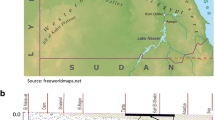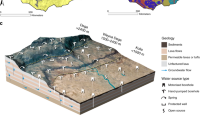Abstract
In developed countries, a number of factors are leading a growing number of households to drill private boreholes as independent water supplies. This chapter describes this phenomenon based on two case studies conducted in Southern France and Western Australia. It shows that, while the development of private wells was encouraged by the authorities in Perth, it is a major source of environmental, public health, economic and social concern for French water utilities. Household’s motivations to develop independent supply are then investigated. We finally discuss how water utilities need to adapt their management practices (setting tariffs, demand forecasting and resource protection) to take into account this phenomenon.
Access this chapter
Tax calculation will be finalised at checkout
Purchases are for personal use only
Similar content being viewed by others
Notes
- 1.
According to NUS consulting European water price barometer (2009), the average water price in France is 10 % lower than the European average (3.09 against 3.44 €/m3) and far below German and Danish prices (respectively 5.29 and 6.42 €/m3). The study is based on an analysis of the 5 largest cities in 10 EU countries, covering a total population of about 40 million inhabitants (Germany, Belgium, Denmark, Spain, Finland, France, Italy, the Netherlands, the United Kingdom, and Sweden).
- 2.
The survey targeted a sample of 2,778 households living in detached houses. They were selected in 100 neighborhoods representative of the diversity of the metropolitan area in terms of income, housing characteristics, groundwater characteristics, and water tariffs. The response rate was just below 10 % (227 answers with 200 fully exploitable).
- 3.
The estimated rate of bore-well ownership in this metropolitan area is high compared to what has been found in other cities. In the nearby Montpellier area for instance, a similar internet survey conducted with 347 households showed a borehole equipment rate of 9 %. The difference is mainly explained by geological conditions.
- 4.
The 2006 water law, modifying article L 2224-12 of the Code Général des Collectivités Territoriales (CGCT) and application decrees of 2/07/2008, 17/12/2008.
- 5.
Article 2224-12-5 of CGCT.
- 6.
Based on a sample of 720 households living in detached houses and monitored during 1998–2000.
- 7.
In 2013 A$, based on quotes provided by drilling contractors in the Perth metropolitan area; equivalent to €2,500–3,500.
- 8.
Up to A$300 (capped at 50 % of the installation cost) offered by Western Australian government as part of the ‘Water Wise’ rebate program.
- 9.
In October and November 2010, almost a thousand garden bore-well users in the Perth metropolitan area were caught breaching restrictions. News release by Department of Water, 9 December 2010. Available at http://www.water.wa.gov.au/News+and+events/News+archive/2010/1711.aspx
- 10.
In the medium term, and as energy prices rise, there could be cross-elasticity because of the cost of electricity or other fuel to provide energy for running the bore.
- 11.
This approach might not work for second homes which are only occupied during summer months. Errors are thus expected to be greater along the coast where seasonal occupancy is more frequent.
References
Appleyard, S. J., Angeloni, J., & Watkins, R. (2006). Arsenic-rich groundwater in an urban area experiencing drought and increasing population density, Perth, Australia. Applied Geochemistry, 21, 83–97.
Australian Bureau of Statistics. (2007). Changing water and energy use in Perth homes. Western Australian Statistical Indicators. Issue 1367.5, pp. 29–34.
Department of Environment. (2004). Perth groundwater atlas (2nd ed.). Perth: Government of Western Australia.
Department of Water. (2009). Strategic policy 2.03: Managing unlicenced groundwater. Perth: Government of Western Australia.
Department of Water. (2011). Operational policy 5.17: Metropolitan domestic garden bores. Perth: Government of Western Australia.
Desprats, J. F., Rinaudo, J. D., Moulin, M., & Graveline, N. (2012). Evaluation des prélèvements d’eau issus de forages domestiques dans les bassins du Coulon-Calavon et de Carpentras (Vaucluse). Report 61565-FR, BRGM (French Geological Survey), Orléans, 61pp.
Graham, S. (2000). Constructing premium network spaces: Reflections on infrastructure networks and contemporary urban development. International Journal of Urban and Regional Research, 24, 183–200.
Hurlimann, A. (2011). Household use of and satisfaction with alternative water sources in Victoria Australia. Journal of Environmental Management, 92, 2691–2697.
Kennewell, C., & Shaw, B. J. (2008). Perth, Western Australia. Cities, 25, 243–255.
Li, Q., Harris, B., Aydogan, C., Ang, M., & Tade, M. (2006). Feasibility of recharging reclaimed wastewater to the coastal aquifers of Perth, Western Australia. Process Safety and Environmental Protection, 84, 237–246.
Loh, M., & Coghlan, P. (2003). Domestic water use study in Perth, Western Australia 1998–2001. Perth: Water Corporation.
Madanat, S., & Humplick, F. (1993). A model of household choice of water supply systems in develo** countries. Water Resources Research, 29, 1353–1358.
Montginoul, M. (2008). Estimation du nombre de forages domestiques – Application au cas des Pyrénées Orientales (66). Report for the Ministry of Ecology. Cemagref – UMR G-Eau, Montpellier, 51pp.
Montginoul, M., & Rinaudo, J.-D. (2011). Controlling households’ drilling fever in France: An economic modeling approach. Ecological Economics, 71, 140–150.
Montginoul, M., Rinaudo, J.-D., de Lajonquière, Y. L., Garin, P., & Marchal, J.-P. (2005). Simulating the impact of water pricing on households behaviour: The temptation of using untreated water. Water Policy, 7, 523–541.
Mu, X., Whittington, D., & Briscoe, J. (1990). Modeling village water demand behavior: A discrete choice approach. Water Resources Research, 26, 521–529.
Nauges, C., & van den Berg, C. (2009). Demand for piped and non-piped water supply services: Evidence from southwest Sri Lanka. Environmental and Resource Economics, 42, 535–549.
Pattanayak, S. K., Yang, J.-C., Whittington, D., & Bal Kumar, K. C. (2005). Co** with unreliable public water supplies: Averting expenditures by households in Kathmandu, Nepal. Water Resources Research, 41, W02012.
Raju, K. V., Manasi, S., & Latha, N. (2008). Emerging ground water crisis in urban areas. A case study of ward no. 39, Bangalore city. Bangalore: Institute for Social and Economic Change.
Roseth, N. (2006). Community views of water shortages and conservation. Salisbury: Cooperative Research Center for Water Quality and Treatment.
Smith, A., Pollock, D., & McFarlane, D. (2005). Opportunity for additional self supply of groundwater from superficial aquifer beneath Metropolitan Perth. Canberra: CSIRO Water for a Healthy Country National Research Flagship.
Syme, G. J., Nancarrow, B. E., & Seligman, C. (2000). The evaluation of information campaigns to promote voluntary household water conservation. Evaluation Review, 24, 539–578.
Syme, G. J., Shao, Q., Po, M., & Campbell, E. (2004). Predicting and understanding home garden water use. Landscape and Urban Planning, 68, 121–128.
Thomas, J. F., & Syme, G. J. (1988). Estimating residential price elasticity of demand for water: A contingent valuation approach. Water Resources Research, 24, 1847–1857.
Thomas, J. F., Syme, G. J., & Salerian, S. N. (1987). Factors influencing bore ownership of residential households in Perth. In Domestic water use study Perth, Western Australia (pp. 72–124). Perth: Water Authority of Western Australia.
Acknowledgments
This chapter was prepared as part of the EAU&3E project funded by the French Research Agency (ANR), grant VD-08-321989. We thank Céline Nauges and Geoffrey Syme for very useful comments on an earlier version of this paper. The usual disclaimers apply.
Author information
Authors and Affiliations
Corresponding author
Editor information
Editors and Affiliations
Rights and permissions
Copyright information
© 2015 Springer Science+Business Media Dordrecht
About this chapter
Cite this chapter
Rinaudo, JD., Montginoul, M., Desprats, JF. (2015). The Development of Private Bore-Wells as Independent Water Supplies: Challenges for Water Utilities in France and Australia. In: Grafton, Q., Daniell, K., Nauges, C., Rinaudo, JD., Chan, N. (eds) Understanding and Managing Urban Water in Transition. Global Issues in Water Policy, vol 15. Springer, Dordrecht. https://doi.org/10.1007/978-94-017-9801-3_7
Download citation
DOI: https://doi.org/10.1007/978-94-017-9801-3_7
Publisher Name: Springer, Dordrecht
Print ISBN: 978-94-017-9800-6
Online ISBN: 978-94-017-9801-3
eBook Packages: Earth and Environmental ScienceEarth and Environmental Science (R0)




